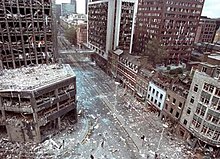1993 Bishopsgate bombing
| 1993 Bishopsgate bombing | |
|---|---|
| Part of The Troubles | |

Wormwood Street pictured in the aftermath of the bombing which occurred on nearby Bishopsgate
|
|
| Location | Bishopsgate, London, United Kingdom |
| Coordinates | 51°30′56″N 0°04′56″W / 51.5156°N 0.0822°WCoordinates: 51°30′56″N 0°04′56″W / 51.5156°N 0.0822°W |
| Date | 24 April 1993 10:27 am (GMT) |
| Target | London's primary financial district |
|
Attack type
|
Truck bomb |
| Deaths | 1 |
|
Non-fatal injuries
|
44 |
| Perpetrators | Provisional Irish Republican Army |
The Bishopsgate bombing occurred on Saturday 24 April 1993, when the Provisional Irish Republican Army (IRA) detonated an ANFO truck bomb on Bishopsgate, a major thoroughfare in London's financial district, the City of London. A news photographer was killed in the explosion and 44 people were injured; the damage cost £350 million to repair. As a result of the bombing, which occurred just over a year after the bombing of the nearby Baltic Exchange, a "ring of steel" was implemented to protect the City, and many firms introduced disaster recovery plans in case of further attacks or similar disasters.
In early 1993 the Northern Ireland peace process was at a delicate stage, with attempts to broker an IRA ceasefire ongoing.Gerry Adams of Sinn Féin and John Hume of the Social Democratic and Labour Party had been engaged in private dialogue since 1988, with a view to establishing a broad Irish nationalist coalition. British Prime Minister John Major had refused to openly enter into talks with Sinn Féin until the IRA declared a ceasefire. The risk of an IRA attack on the City of London had increased due to the lack of progress with political talks, resulting in a warning being circulated to all police forces in Britain highlighting intelligence reports of a possible attack, as it was felt the IRA had sufficient personnel, equipment and funds to launch a sustained campaign in England. During the Troubles the IRA had bombed financial targets in London on a number of occasions, most notably on 10 April 1992 when a truck bomb exploded outside the Baltic Exchange on St. Mary Axe. The Baltic Exchange bombing caused £800 million worth of damage (the equivalent of £1,470 million in 2017), £200 million more than the total damage caused by the 10,000 explosions that had occurred during the Troubles in Northern Ireland up to that point.
...
Wikipedia
